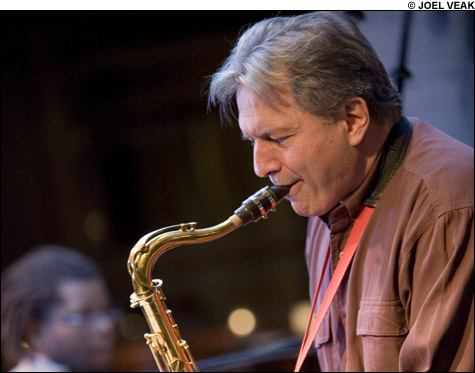
COOLING IT: The hardest part for music students, says Bergonzi, is “learning to be yourself.” |
The scene is typical for a Boston jazz date: high-profile, at a major club, but with minimal preparation, because of the multiple obligations of musicians who are in demand as sidemen and teachers. The “special guest” is tenor-saxophonist Jerry Bergonzi. Handsome, gray-haired, dressed for business in a suit jacket and white shirt, Bergonzi glances at the leader, Aruan Ortiz, behind the piano, then down at the music stand in front of him. He and Ortiz exchange a few words. If this isn’t a “cold” run-through, it’s pretty close. The piano kicks off a vamp with bass and drums; then there’s a jagged rhythmic theme with harmonic leaps and an Afro-Cuban undercurrent. Bergonzi’s tenor enters with a rush of notes, big-toned and strong, slicing through the material, free, but also adhering to the form — in fact, bringing it into sharper focus. Like a magnet on a sheet of iron filings, his tenor shapes the piece around it even as he makes a riveting personal statement.
Bergonzi has long been recognized as a master and a consummate pro — someone who not only gets the job done but also makes real music in even the most challenging situations. He emerged in the ’80s amid a pack of Coltrane-influenced saxophonists: Davie Liebman, Michael Brecker, Steve Grossman, Bob Berg. The Coltrane “sheets of sound” were everywhere — which may be one reason Bergonzi was best appreciated by fellow musicians. “It’s something saxophonists have known about for more than 25 years,” says Allan Chase, who teaches with Bergonzi at New England Conservatory. “He has a great sound that immediately reaches all kinds of people, but there’s also a complexity to what he plays that’s very intricate and imaginative — and also mathematically amazing.” Brecker — who before he died this past January was widely recognized as the most influential of all post-Coltrane saxophonists — was a frequent Bergonzi booster. Asked once whether he still practiced every day, he replied, “As long as Jerry Bergonzi is around, no tenor player can rest on his laurels.”
Bergonzi’s latest CD as a leader, Tenorist (Savant), is waking more people up to what all those saxophonists have known. It also supports the point Chase makes that Bergonzi, despite his early mastery, has never stopped growing. On his 1990 Blue Note CD, Standard Gonz, you can hear the style fully formed: the speed, the articulation, the harmonic and rhythmic facility, and a big, expressive sound. But Tenorist is a departure, even from Bergonzi’s previous Savant CD, Tenor of the Times. Here, working with guitarist John Abercrombie instead of a piano, he’s created nine hooky, concise tunes that flow with unprecedented freedom. Bergonzi these days is leaving more space, changing up his phrasing mid solo to, say, depart from a string of chord-running eighth notes to a series of descending odd intervals full of rests and half notes. That “mathematical” logic that Chase talks about holds the pieces and the solos together as Bergonzi stretches out. Standard song forms and chord progressions have been altered and refitted to create an effect of tantalizing ambiguity — and humor. Bassist Dave Santoro and drummer Adam Nussbaum swing even as they negotiate Bergonzi’s odd rhythmic patterns. Santoro rarely steps into 4/4 walking, but the pulse is always there, as he hangs back from the beat while Nussbaum pushes forward, enhancing the elastic rhythms. Bergonzi, meanwhile, seems to be lavishing more attention on individual notes — the sighs, shouts, and vocal syllables of each. The CD makes an argument for jazz as a language that’s constantly renewing itself. In a New York Times review, Ben Ratliff called Tenorist “a casually great jazz record.”